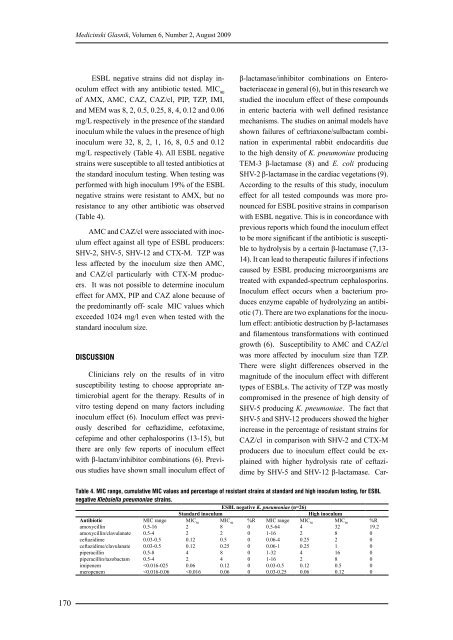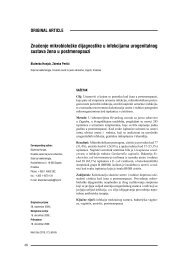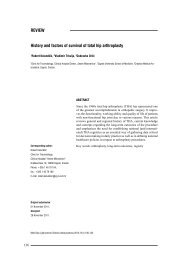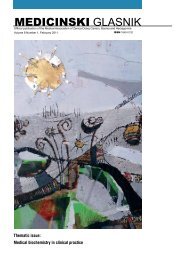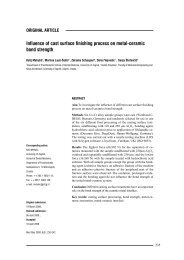MEDICINSKI GLASNIK
MEDICINSKI GLASNIK
MEDICINSKI GLASNIK
You also want an ePaper? Increase the reach of your titles
YUMPU automatically turns print PDFs into web optimized ePapers that Google loves.
170<br />
Medicinski Glasnik, Volumen 6, Number 2, August 2009<br />
ESBL negative strains did not display in-<br />
oculum effect with any antibiotic tested. MIC 90<br />
of AMX, AMC, CAZ, CAZ/cl, PIP, TZP, IMI,<br />
and MEM was 8, 2, 0.5, 0.25, 8, 4, 0.12 and 0.06<br />
mg/L respectively in the presence of the standard<br />
inoculum while the values in the presence of high<br />
inoculum were 32, 8, 2, 1, 16, 8, 0.5 and 0.12<br />
mg/L respectively (Table 4). All ESBL negative<br />
strains were susceptible to all tested antibiotics at<br />
the standard inoculum testing. When testing was<br />
performed with high inoculum 19% of the ESBL<br />
negative strains were resistant to AMX, but no<br />
resistance to any other antibiotic was observed<br />
(Table 4).<br />
AMC and CAZ/cl were associated with inoculum<br />
effect against all type of ESBL producers:<br />
SHV-2, SHV-5, SHV-12 and CTX-M. TZP was<br />
less affected by the inoculum size then AMC,<br />
and CAZ/cl particularly with CTX-M producers.<br />
It was not possible to determine inoculum<br />
effect for AMX, PIP and CAZ alone because of<br />
the predominantly off- scale MIC values which<br />
exceeded 1024 mg/l even when tested with the<br />
standard inoculum size.<br />
DISCUSSION<br />
Clinicians rely on the results of in vitro<br />
susceptibility testing to choose appropriate antimicrobial<br />
agent for the therapy. Results of in<br />
vitro testing depend on many factors including<br />
inoculum effect (6). Inoculum effect was previously<br />
described for ceftazidime, cefotaxime,<br />
cefepime and other cephalosporins (13-15), but<br />
there are only few reports of inoculum effect<br />
with β-lactam/inhibitor combinations (6). Previous<br />
studies have shown small inoculum effect of<br />
β-lactamase/inhibitor combinations on Enterobacteriaceae<br />
in general (6), but in this research we<br />
studied the inoculum effect of these compounds<br />
in enteric bacteria with well defined resistance<br />
mechanisms. The studies on animal models have<br />
shown failures of ceftriaxone/sulbactam combination<br />
in experimental rabbit endocarditis due<br />
to the high density of K. pneumoniae producing<br />
TEM-3 β-lactamase (8) and E. coli producing<br />
SHV-2 β-lactamase in the cardiac vegetations (9).<br />
According to the results of this study, inoculum<br />
effect for all tested compounds was more pronounced<br />
for ESBL positive strains in comparison<br />
with ESBL negative. This is in concordance with<br />
previous reports which found the inoculum effect<br />
to be more significant if the antibiotic is susceptible<br />
to hydrolysis by a certain β-lactamase (7,13-<br />
14). It can lead to therapeutic failures if infections<br />
caused by ESBL producing microorganisms are<br />
treated with expanded-spectrum cephalosporins.<br />
Inoculum effect occurs when a bacterium produces<br />
enzyme capable of hydrolyzing an antibiotic<br />
(7). There are two explanations for the inoculum<br />
effect: antibiotic destruction by β-lactamases<br />
and filamentous transformations with continued<br />
growth (6). Susceptibility to AMC and CAZ/cl<br />
was more affected by inoculum size than TZP.<br />
There were slight differences observed in the<br />
magnitude of the inoculum effect with different<br />
types of ESBLs. The activity of TZP was mostly<br />
compromised in the presence of high density of<br />
SHV-5 producing K. pneumoniae. The fact that<br />
SHV-5 and SHV-12 producers showed the higher<br />
increase in the percentage of resistant strains for<br />
CAZ/cl in comparison with SHV-2 and CTX-M<br />
producers due to inoculum effect could be explained<br />
with higher hydrolysis rate of ceftazidime<br />
by SHV-5 and SHV-12 β-lactamase. Car-<br />
Table 4. MIC range, cumulative MIC values and percentage of resistant strains at standard and high inoculum testing, for ESBL<br />
negative Klebsiella pneumoniae strains.<br />
ESBL negative K. pneumoniae (n=26)<br />
Standard inoculum High inoculum<br />
Antibiotic<br />
amoxycillin<br />
MIC range<br />
0.5-16<br />
MIC50 2<br />
MIC90 8<br />
%R<br />
0<br />
MIC range<br />
0.5-64<br />
MIC50 4<br />
MIC90 32<br />
%R<br />
19.2<br />
amoxycillin/clavulanate 0.5-4 2 2 0 1-16 2 8 0<br />
ceftazidime 0.03-0.5 0.12 0.5 0 0.06-4 0.25 2 0<br />
ceftazidime/clavulanate 0.03-0.5 0.12 0.25 0 0.06-1 0.25 1 0<br />
piperacillin 0.5-8 4 8 0 1-32 4 16 0<br />
piperacillin/tazobactam 0.5-4 2 4 0 1-16 2 8 0<br />
imipenem


